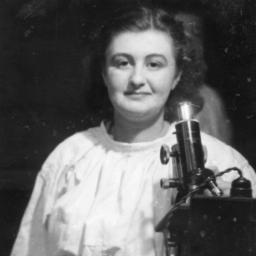Anne Crawford “Nancy” Allen Holst

The first woman to join the International Association of Fire Chiefs, “Chief Nancy” led Rode Island’s Cedar Hill Volunteer Fire Department beginning in 1931. Determined to protect her family home from forest fires, she used her skills as a firefighter and pilot to safeguard her community for decades.
Born June 22, 1908 in Warwick, Rhode Island to Helen Slater Reed and Philip Allen, Anne Crawford “Nancy” Allen Holst came from a prominent Rhode Island family. She and her two brothers, Philip Allen, Jr. And William Slater Allen, were descendants of Roger Williams, the founder of Rhode Island. Holst’s nickname “Nancy” derived from a contraction of “Anne C.” As a child, Holst was known to chase after fire trucks that passed by their home on the east side of Providence. She told a reporter in 1937 of her early fascination with fires: “[My father and brothers] would not walk 100 yards to see a fire. I’d go 100 miles.”
Holst attended Miss Hall’s School in Pittsfield, Massachusetts and graduated from the Mary C. Wheeler School in Providence in 1926. Like many other young women of means in the era, she embarked on a “Grand Tour” of Europe after high school. Other girls in her tour group were taking flying lessons back home and piqued Holst’s interest in aviation. When she returned to Providence, she started taking flying lessons of her own.
It was also then that Holst began fighting fires that threatened her family’s estate, Cedar Hill, each spring and fall. Holst noticed that the fires were growing larger and more frequent, so she decided to take action. In 1931, Holst organized and financed the Cedar Hill Volunteer Fire Department in Warwick. The 15 men who volunteered to join the department unanimously elected Holst as fire chief. From then on, she was known as “Chief Nancy.”
Holst purchased a used 1928 Dodge-Graham truck and with the help of friends and neighbors, oversaw its conversion into a fire engine. Holst furnished the truck with contemporary fire-fighting equipment: more than 1,000 feet of fire hose, two motor-driven pumps, buckets, extinguishers, shovels, and a first-aid kit. She also added a generator with 500 feet of cable to power three portable floodlights to aid nighttime work. Holst even designed the firehouse in which they stored the truck. Fully outfitted, the Cedar Hill Volunteer Fire Department fought forest and residential fires across Rhode Island.
On May 24, 1936, Holst secured her reputation as a skilled and courageous firefighter. A large brush fire broke out, fanned by strong winds. Cedar Hill responded along with seven other companies. The head fire chief told her, “We’ve got a bad blaze on our hands. Get in there with your men and fight.” Several firefighters from other companies, including the chief, became trapped by the fire. Holst drove in to the blazing woods and found the chief. When he passed out in her car, she applied artificial respiration. Holst then assisted state police in locating the rest of the trapped firefighters, resulting in their rescue.
That same year, Holst became the first woman to join the International Association of Fire Chiefs. She also joined the Ninety-Nines, the International Organization of Women Pilots. She piloted her Fairchild cabin monoplane (which she donated to the Cedar Hill fire department) and was likely the first American woman to fly over a forest fire. In one reported example from 1937, Holst was flying when she spotted a house directly in the path of a fire. Lacking a radio to communicate with firefighters on the ground, she swooped her plane over the home to attract their attention, enabling the firefighters to save the home. Following the Great New England Hurricane of 1938, the U.S. Forest Service asked Holst to fly over land that had been in the storm’s path to assess the damage. She was likely the first female pilot to fly for the agency, predating any others by nearly 40 years.
While chief of the Cedar Hill company, Holst also worked for the Rhode Island Forest Fire Service. She was the first woman in the state named a forest fire warden, as well as the first woman to publish an article in the U.S. Forest Service’s journal Fire Control Notes (now titled Fire Management Today). She then rose to the position of deputy state fire marshal. In that capacity, she developed Rhode Island’s first forest fire control plan.
It was through her work that she met Monterey L. Holst, a forester from the Siuslaw National Forest in Oregon. The two married in 1940. A photo of Holst wearing a white fire chief’s hat and wedding gown while the couple left the ceremony in her fire truck, made newspapers around the country. The couple established the Cedar Hill Forest Fire Experiment Station in 1940, where they tested new firefighting strategies and equipment. In 1942, the couple had a daughter, Anne D. Holst.
In 1957, the Cedar Hill Volunteer Fire Department closed its doors, but Holst continued to be active in many pursuits. Holst was a longtime member of numerous organizations, including: the Providence Female Charitable Society, the Junior League of Providence, the Rhode Island Chapter of the American Red Cross, the Girl Scouts of America, the Garden Club of America, the Rhode Island Historical Society, and, of course, the New England Chapter of the International Association of Fire Chiefs. She served as a reporter and columnist for the East Greenwich Pendulum, a local weekly, and regularly contributed articles to the publications of her many associations.
Holst passed away on July 29, 1997 at the age of 89. In 2004, Holst’s home in Warwick (where her daughter still resides) opened as the Clouds Hill Victorian House Museum. The firehouse Holst designed still stands near the home, along with the fire truck she outfitted – a testament to the courage and ingenuity of the first female fire chief.
Published 2021.
- Holst, Anne D. “Anne Crawford "Nancy" Allen Holst and The Cedar Hill Volunteer Fire Department.” Clouds Hill Museum. Accessed October 28, 2021. https://www.cloudshill.org/chief-nancy
- Holst, Anne D. Email message to author. October 17, 2021.
- Henson, Carol. “Chief Nancy: The story of the first woman to join the IAFC.” International Association of Fire Chiefs. January 2021. Accessed October 28, 2021. https://www.iafc.org/iCHIEFS/iCHIEFS-article/chief-nancy
MLA – Brandman, Mariana. “Anne Holst.” National Women’s History Museum, 2021. Date accessed.
Chicago – Brandman, Mariana. “Anne Holst.” National Women’s History Museum. 2021. www.womenshistory.org/education-resources/biographies/anne-holst
Photo Credit: Photo courtesy of Anne D. Holst, Clouds Hill Museum.
Hutton, Jane. “The Hurricane of 1938: An Oral History Told by Nancy Allen Holst, Forest Fire Warden and Pilot Part I: The Devastating Damage She Witnessed.” The Online Review of Rhode Island History. http://smallstatebighistory.com/the-hurricane-of-1938-an-oral-history-told-by-nancy-allen-holst-forest-fire-warden-and-pilot-part-i-the-devastating-damage-he-witnessed/




